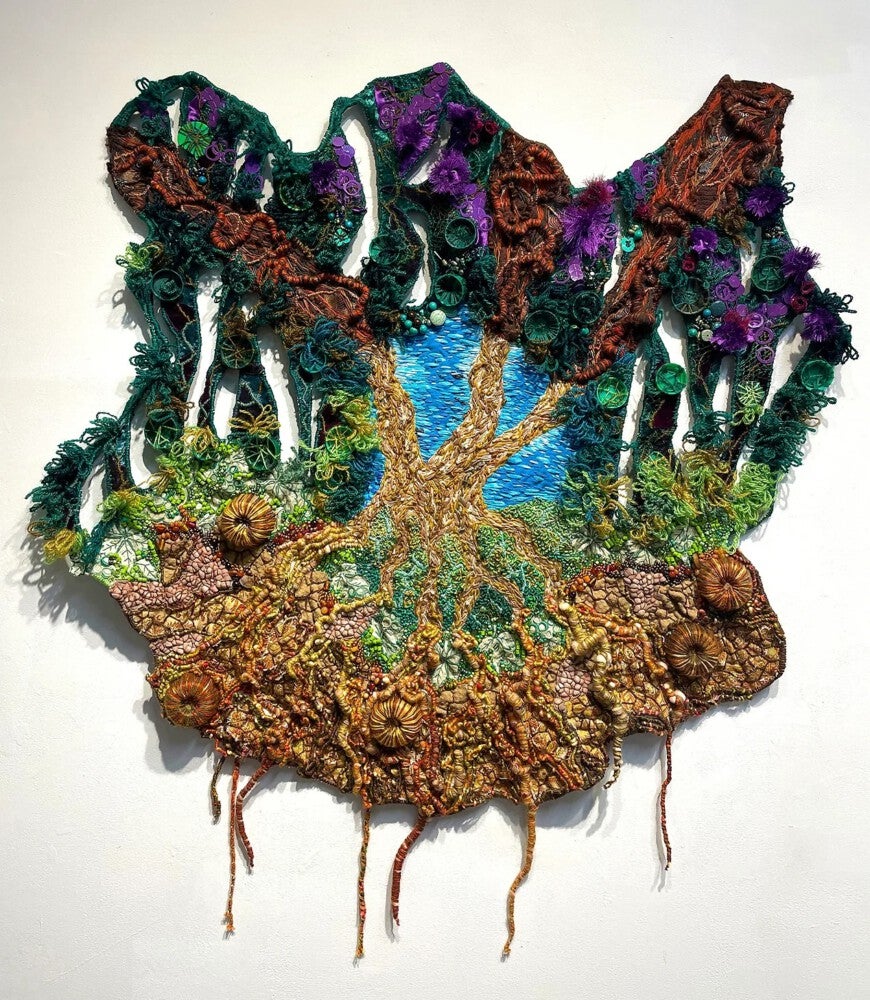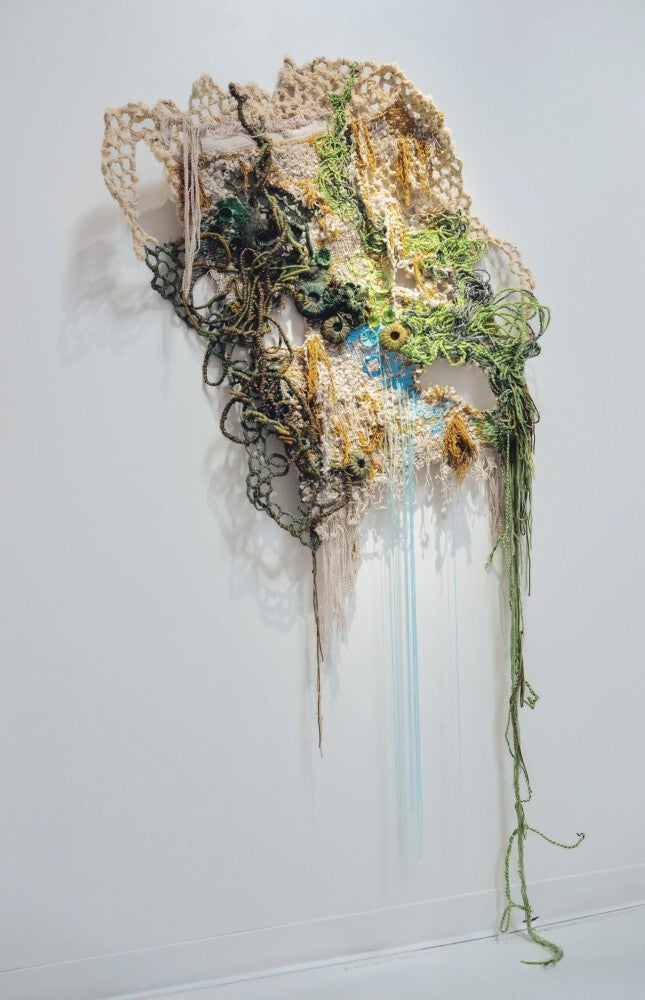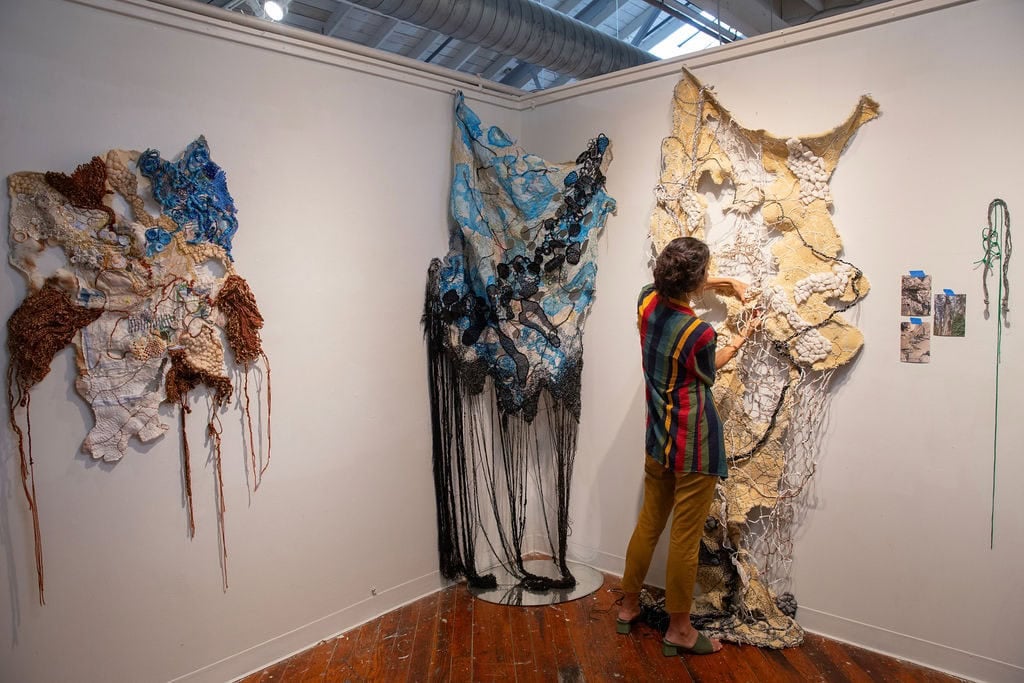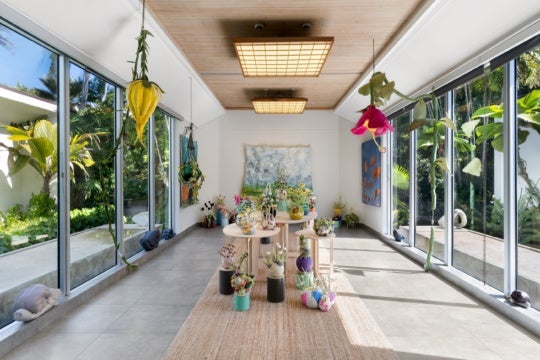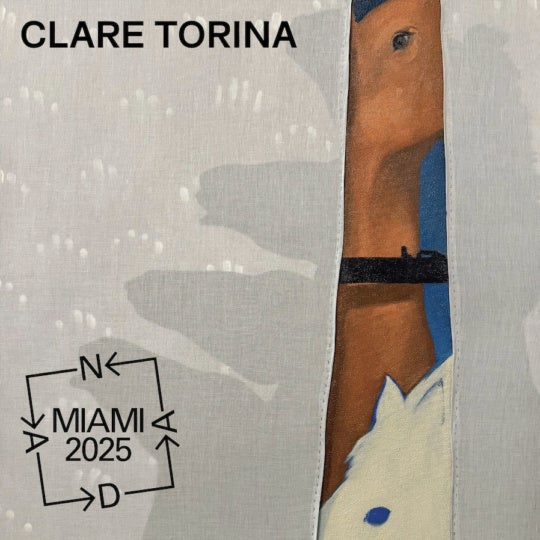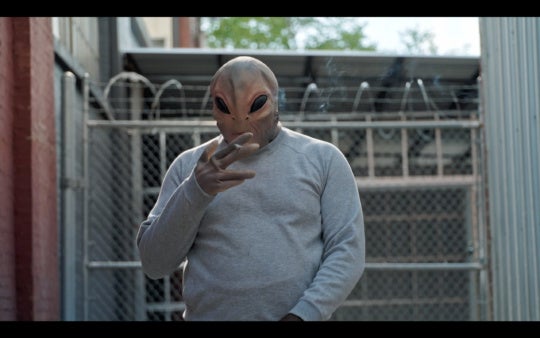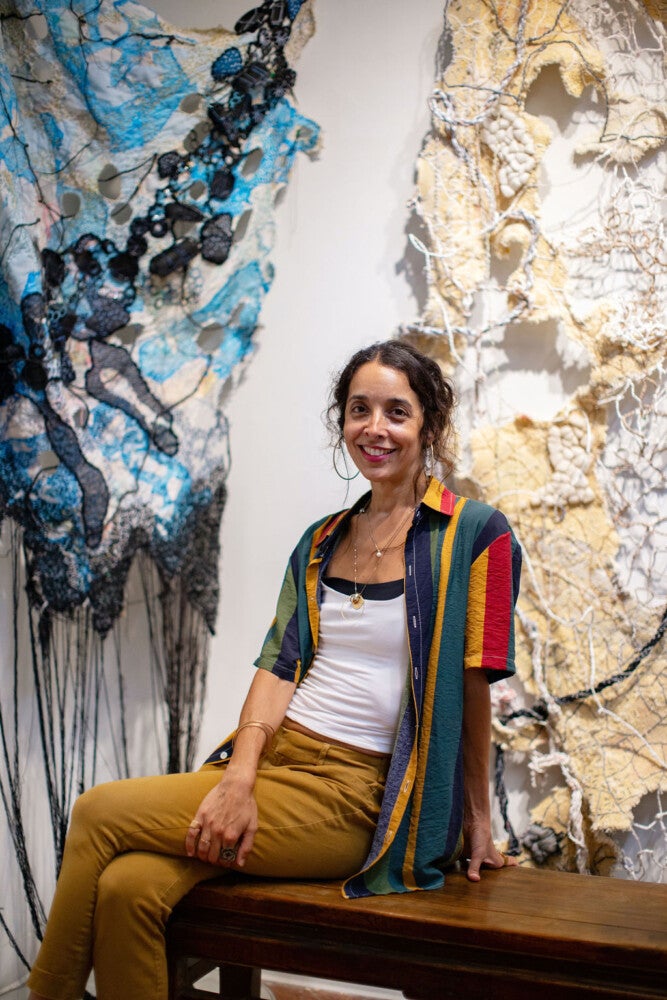
In Patrizia Ferreira’s Raleigh studio, there’s alchemy at work. Bins of yarn and thread cover the floor and piles of nets, ropes, and discarded plastic bottlecaps cover the tables. Was it all just pulled from the trash? Maybe, it’s hard to tell. But one thing seems certain: this miscellany couldn’t possibly transform into the polished works that hang on the walls. And yet somehow, it does, inviting the viewer along for the ride.
Ferreira’s currently reading Alejo Carpentier, a Cuban author known for his magical realism, and it’s a telling choice. To view Ferreira’s work is to be at once grounded in the bodily grit of here and now and somehow also transported into a space beyond it. It’s colorful, mesmeric, endlessly detailed, and deeply process-driven, giving reality a sheen of something you can’t quite name.
As the 2024 Artspace Emerging Artist in Residence, Ferreira has a high bar to meet, but she’s welcoming the challenge and community that comes with it, one stitch at a time. I met the artist at her studio on a Tuesday to discuss her process and unusual medium. The following conversation was edited for length and publication.
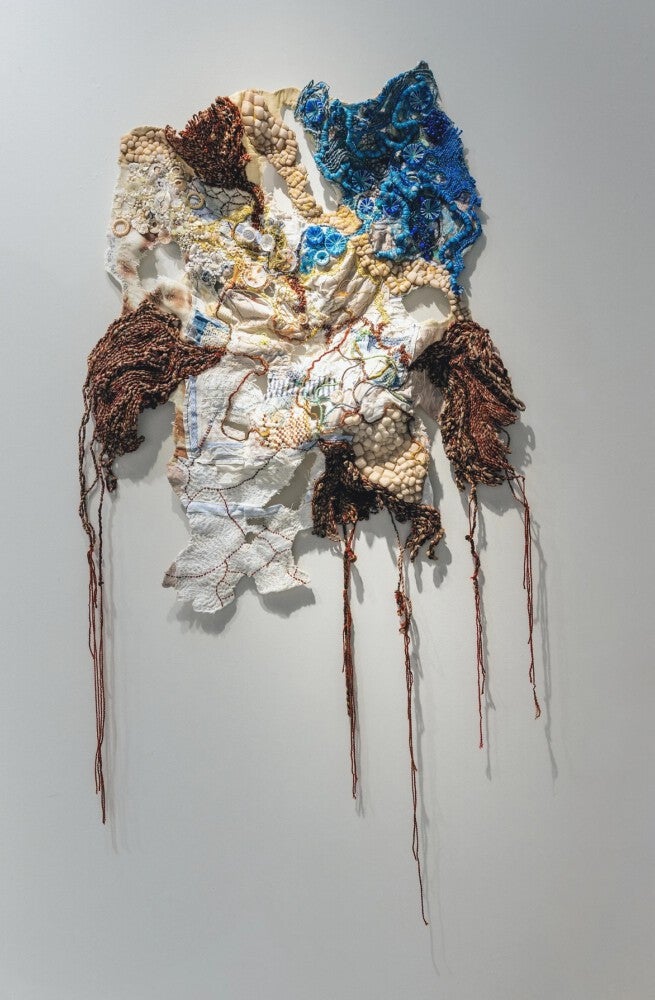
Susanna Klingenberg: You work with so many different media, and the more I study your pieces, the more layers and textures I notice. What shapes your choices?
Patrizia Ferreira: I use all kinds of materials in my work, anything from fabric remnants, to old tattered rugs, to discarded plastic, to metal clothes hangers. Once, I even used a bike tire! I’m drawn to broken things and things that people throw away. But I’m first, and wholeheartedly, a textile artist. My work may look sculptural and move away from the wall and have hard objects woven into it, but I’m always making some form of fabric. In the end, everything is put together through stitches, through yarn and thread connecting the many pieces, the many parts. Fiber is always the base of it; it’s the glue.
People do ask me sometimes why I use garbage in my work, why I’m drawn to brokenness. I love the challenge of making something beautiful out of these disconnected, hard, and ugly things…things that are not inherently beautiful. I think it’s related to my upbringing with a mom who recycled everything and could put together the most random things and make them look interesting. She’ll find a branch and place it next to a marble sculpture, and the combination of such disparate objects suddenly has this intriguing volume…it creates an evocative dialogue. I love the creativity and surprise of found objects. It keeps me coming back.
SK: It sounds straight out of the magical realism you’re reading right now.
PF: Right! It’s like you’re stumbling into a world you didn’t see coming. When you find an object, it’s like, okay, this is the world we’re in, here we go, let’s do this. Found objects are an extension of life. They’re also a reminder that nature is constantly working, through time, to wear things out. So it makes you ask, “Who’s really the artist here?” Sometimes I feel like I’m stealing these objects, because I’m not making them—I’m just taking.
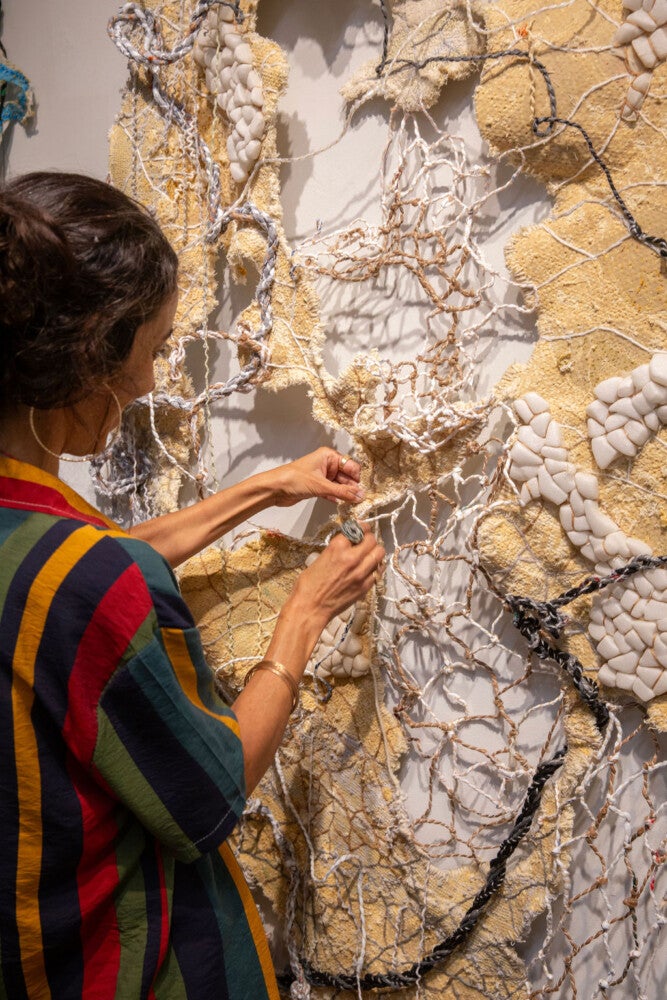
SK: You work entirely by hand, no machines. Why is that important to you?
PF: When I stitch, when I stay stubborn about this way of making, it requires a big effort, and it’s not always enjoyable, to be honest. It would be much easier to just paint over it or use glue or a sewing machine, you know?
But it’s a form of resistance. I’m resisting efficiency, this pressure society imposes on me, on us, to be faster, make more, do more. I want to stick with this slow, hands-on approach because I think there’s true wisdom there. I want the pieces to speak of the humanity we all share, that makes us who we are—beautiful and vulnerable at the same time. Bringing a machine into it would create much sturdier, harder pieces instead of the fragile, collapsing creations I am able to make with stitches.
When I put work together with my hands, it creates a connection to people, because it gives them something to relate to, something they can understand. They understand stitches, they understand yarn. It takes you back to the origins of humankind, to this ancestral practice of stitching, sewing, making ropes and nets, using our hands.
SK: Your specific ancestral practices are from Uruguay, but you’ve lived and worked in so many places. How does that inform your practice?
PF: I’m always thinking about borders, manmade or otherwise. The big border I crossed was, of course, coming to the US. But there’s also all the emotional borders you cross when switching cultures and merging cultures. I mean, I’ve been a US citizen for over ten years, but it doesn’t matter: I still have the immigrant identity. So, there’s this constant shifting, moving between.
In my work, I like exploring this idea of what’s on one side, what’s on the other, who’s on one side, who’s on the other, what’s up, what’s down, north and south. There’s this idea of borders dividing, but also, like in the US or in a continent, borders are the things that hold disparate pieces together, you know? Working with disparate pieces, held together with stiches, is a way for me to reconcile all these parts in me that I feel are kind of broken, that can’t quite connect with each other, that the immigrant experience has moved around and shaken up.
